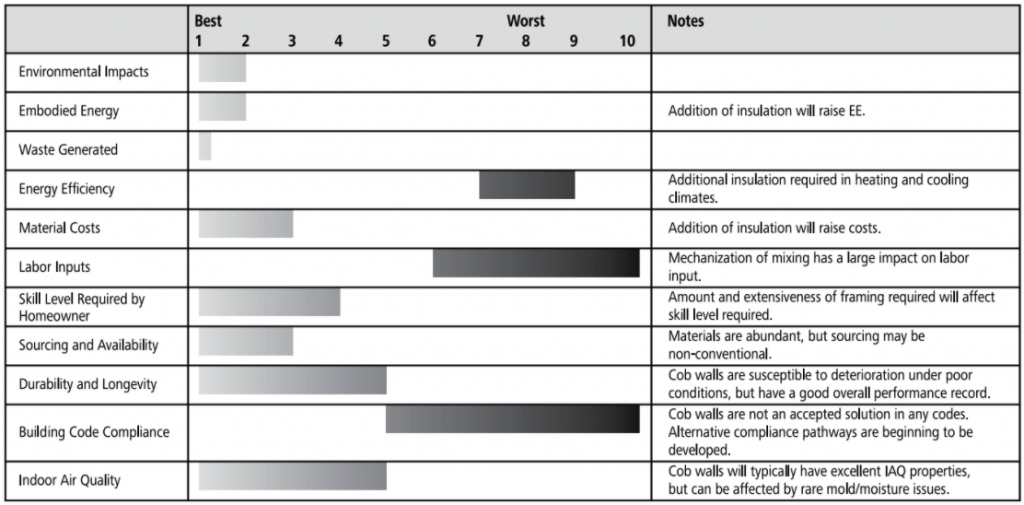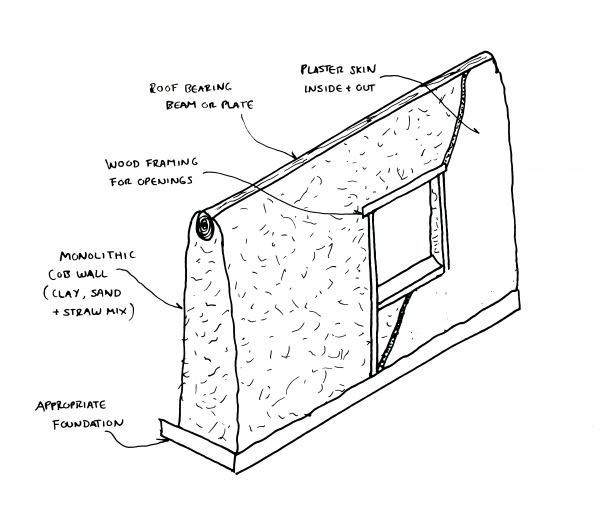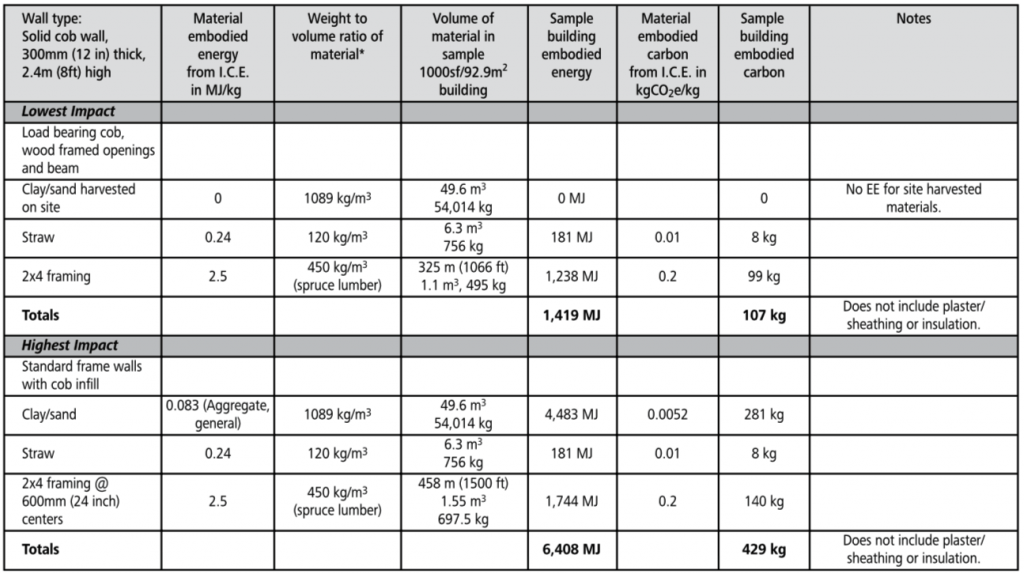Cob
Walls: MATERIALS ENCYcLOPEDIA
Applications for this system
Load-bearing and infill exterior walls
interior walls
Built-in furniture, benches
Decorative elements
Basic materials
Soil with adequate clay content
Sand/aggregate
Straw
Plasters for finish
Framing lumber, if used as infill
Control layers:
Water — Plaster is the most common material for this layer, though any kind of rainscreen siding can be used.
Air — The cob wall itself controls air movement, as it is solid and continuous. If well detailed at intersections with floor, ceiling and openings, it is possible to build an airtight wall with no additional control layers.
Vapor — The cob regulates vapor movement and is a permeable wall system. If gross air leakage is controlled, then vapor will need to diffuse through the wall system. Cob has a large storage capacity for moisture and high perm ratings.
Thermal — In most cob construction, the mud/straw mix is relied upon for thermal control. Thermal performance rises with higher straw content, but in general cob does not perform well thermally. An additional thermal control layer can be added in the middle of a cob wall or on either side of the wall, using a range of different insulation materials.
Ratings Chart for Cob Walls

The ratings chart shows comparative performance in each criteria category. Click on the tabs below for detailed analysis of each criteria.
- HOW THE SYSTEM WORKS
- ENVIRONMENTAL IMPACTS
- WASTE
- EMBODIED CARBON
- ENERGY EFFICIENCY
- MATERIAL COSTS
- LABOUR INPUT
- SKILL LEVEL REQUIRED
- SOURCING & AVAILABILITY
- DURABILITY
- CODE COMPLIANCE
- INDOOR AIR QUALITY
- RESOURCES
- FUTURE DEVELOPMENT
cob System

A soil with clay content of 10–40 percent and a good distribution of sand and silt is moistened and thoroughly mixed with chopped straw or other natural fiber. The resulting mix is hand-formed into walls that can bear the weight of floors/roofs using a ring beam, usually made of wood or concrete. Cob can also be used as an infill in a wide variety of frames, including light wood frames, post and beam and timber frames.
Window and door openings are typically created using wooden frames, often built identically to openings in code-approved frame walls, though the details of these can vary widely.
The actual percentages of clay, sand, silt and straw in a cob mix will vary with soil types, region and builder preference. Cob mixtures are very forgiving, with a wide range of mix percentages resulting in feasible walls. There are many resources available to help a builder test and assess cob mixes.
Hand-formed walls are built in “lifts,” with cob being added around the walls until the point where the weight of additional wet cob might cause deformation. Straw, sticks and finger holes are used to ensure adequate mechanical bond between lifts. Once built, the wall is monolithic.
Cob walls are not typically made with any sort of formwork, though it is possible to use forms for a more uniform wall surface.
The finished cob walls are usually treated with one or more coats of earthen plaster, which bonds directly to the cob wall surface. The plaster mixtures are very similar to the cob, using the same basic ingredients in slightly different ratios. Lime plasters are occasionally used for their ability to last longer when exposed to precipitation, but may be prone to delaminating from the cob. Plasters with cement content are rarely used because they have much lower permeability than the cob and can trap moisture in the wall.
Cob walls have a long and proven history in a wide range of geographical locations. The addition of insulation adds a complexity that detracts from the simple efficiency of cob, so the material is not as widely used in colder locations. In general, it is used for small, simple and artistic homes, cottages and cabins, though there are numerous large cob structures as well.
Environmental Impact Rating
Harvesting — Negligible to Moderate
Site soil can be harvested with negligible impacts. Amending materials like sand and clay have low to moderate impacts including habitat destruction and water contamination from quarrying. Straw is harvested with low to moderate impacts including water contamination from crop spraying.
Manufacturing — Negligible to Low
Cob can be mixed without the use of machinery, resulting in negligible impacts. The use of mechanical mixing equipment has relatively low impacts.
Transportation — Negligible to Low
Sample building uses 54,014 kg of soil:
50.8 MJ per km by 35 ton truck
Site soil requires no transportation. Soil, sand and clay are heavy materials and accrue impacts proportional to distance traveled. In most regions these materials can be sourced very close to the building site.
Installation — Negligible
Waste: Very Low
Biodegradable/Compostable — All cob ingredients.
Chart of Embodied energy & carbon
Energy Efficiency: Low
R-0.3 to 0.9 per inch
Cob does not offer a lot of thermal resistance. It is a massive material, and as such works well in climates where thermal mass is an appropriate strategy for maintaining comfortable temperatures (see Thermal Mass vs. Insulation sidebar). The addition of straw in the mix helps add some insulation value compared to solid earth, but the cob will lose its structural integrity if enough straw is added to provide reasonable thermal performance for northern climates, and will have transformed into light clay/straw (see section this chapter) and require a structural frame. Energy efficiency, then, depends on the climate. In the right climate, cob alone can work. In cold climates, additional insulation will need to be added and the energy efficiency will depend on the values of that insulation and the effectiveness of the other control layers.
Material costs: Low
The basic materials for a cob wall can be very inexpensive, especially if site soils are most or all of the mix. Lumber for framing openings will be an additional cost, and if a skeletal frame of any kind is being used this too will contribute costs. Costs for an insulation layer, if necessary, will depend on the type of insulation used.
Labour Input: High
Cob walls are hand-built, and that means lots of manual labor. If the mix is being stomped by foot, the amount of labor increases further. Machine mixes will save on this time. Typically, cob walls are built with many hands so a lot of labor can be accomplished in a relatively short amount of time. This work is usually volunteer-based, as it would be costly to have to pay for the labor input a cob wall system requires.
Skill level required for homeowners: Low to moderate
With forgiving mixes and free-form hand-placement of the wall material, cob is among the most straightforward and beginner-friendly building systems. It is common for new builders to learn while helping others build walls, and then pass on the knowledge to those who helped them build their walls. An experienced cob builder will have time- and labor-saving knowledge and understand detailing for durability, but this information is available through resources for beginners.
Sourcing & availability: Easy
If the site soils are appropriate for cob, then sourcing is easy. Even if sand or clay need to be imported, they are widely available from masonry supply and pottery supply outlets. Straw can be obtained directly from local farms or farm supply stores, and may require some effort to obtain. Lumber can come from local sawmills with some research, or easily from building supply stores.
Durability: moderate to High
Cob structures have lasted centuries in many different parts of the world. The cob mix is susceptible to long-term erosion from rain, but it is also infinitely repairable. A good roof overhang and proper elevation above grade are the easiest way to ensure minimal exposure to precipitation. A plaster finish can prevent the cob from being damaged by driving rains. If the plaster is well maintained, the cob itself should never see inclement conditions. There are paints and treatments that can be used on the earthen plasters to help them be more durable in wet conditions (see Chapter 9: Surface Finishing Materials), reducing regular maintenance requirements.
Code compliance
Cob is not currently an acceptable solution in any building codes. Many cob buildings are unpermitted, and are often small enough to fall into the legally unpermitted category. In the past decade, there have been a few examples of cob buildings being permitted through alternative compliance mechanisms, and these set a good precedent for builders wishing to attempt permitted cob structures.
Indoor air quality
Clay walls have hygroscopic qualities that enable them to store vast amounts of moisture, rather than having moisture condense on the wall surface and potentially cause mold issues. Other desirable IAQ qualities are attributed to clay walls, including an ability to absorb toxins from the air and a negative ion nature that helps balance positive ion charge (static electricity) and can potentially reduce airborne dust and allergen particles.
Because cob is made from unprocessed site soils, the contents of the soil end up in the walls. If soils were contaminated in any way or release radon gas, this would be problematic. If you have any concerns about the soil, testing is recommended.
Resources for further research
Weismann, Adam, and Katy Bryce. Building with Cob: A Step-by-Step Guide. Totnes, Devon: Green, 2006. Print.
Evans, Ianto, Linda Smiley, and Michael Smith. The Hand-Sculpted House: A Philosophical and Practical Guide to Building a Cob Cottage. White River Junction, VT: Chelsea Green, 2002. Print.
Bee, Becky. The Cob Builders Handbook: You Can Hand-Sculpt Your Own Home. Murphy, OR: Groundworks, 1997. Print.
Schofield, Jane, and Jill Smallcombe. Cob Buildings: A Practical Guide. Crediton, Devon: Black Dog, 2004. Print.
Future development
Cob is a low-tech building system, and the majority of its advocates appreciate the simplicity. Cob mixes could certainly be produced commercially, but there is currently little drive to develop or use such systems. Part of the appeal of cob is that it is made and used today in the same way it was made and used centuries ago.
Positive movement toward testing and code compliance is likely to occur over the next decade or two, as interest in low-impact building makes cob an attractive choice.
The development of insulation strategies that combine well with cob will help to make these walls more applicable in cold climates.
Tips for a successful cob wall
1. Find out if site soils are appropriate for making cob. Soils with too much clay can be amended with additional sand and those that are naturally too sandy can have bagged clay or imported local clay soils added. Because cob mixtures are feasible with a wide range of clay/sand/silt ratios, there is usually a way to make local soils work.
2. Create a mixing system that is appropriate to the size of the walls being built. “Cob stomping” — the mixing of cob using bare feet on a tarp — can be fun and is often the image associated with cob construction, but it is not a fast way to mix cob. For larger projects or those with time restraints, a more mechanized system will be useful. Check Resources for Further Research section at the end of this chapter for tips on mixing in a variety of ways including animals, mortar mixers, tractors and backhoes.
3. As a hand-sculpted, freeform construction style, cob walls lend themselves to creative, curvy designs. This is very liberating from a design point of view, but remember that doors, windows and a roof will need to fit the walls and these elements must be adapted to rounded shapes. Make sure that your plans account for how these elements will interact with the cob walls.
4. Make walls of an appropriate thickness. The taller and straighter the walls, the wider they will need to be. It is common for cob walls to taper from a wider base to a narrower top. Check resources for guidelines about wall thickness.
5. Cob walls can take a long time to build and then a long time to dry out thoroughly. Projects in cold climates or climates with a long rainy season need to be timed to leave adequate drying time before completion of finishes and occupancy.
6. In wet or cold climates, proper detailing needs to be addressed at the foundation, tops of walls and around openings to ensure proper drainage planes, air sealing and protection from rising damp.
7. Cob invites community, so make sure you include others in a cob wall project. As a user-friendly, safe and fun way to build, a cob wall-raising is a memorable event to be shared with friends and family.




